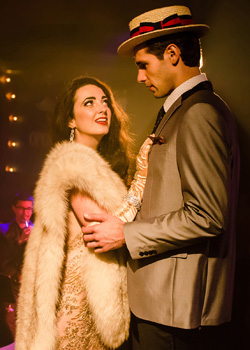Ars Nova Goes Long with Rhyming Burlesque Farce Eager to Lose
It took four collaborators two years to create this idiosyncratic piece. They couldn’t have done it without the help of the midtown performance space that champions new and untested work.

(© Marielle Solan)
If Molière got hammered on Maker’s Mark and decided to write an episode of I Love Lucy in which everyone gets naked, it would probably look something like Eager to Lose, the burlesque verse farce currently playing at Ars Nova. Home of the original run of the popular and critically acclaimed Natasha, Pierre & the Great Comet of 1812, Ars Nova has a history of supporting new and nontraditional work. “Eager to Lose is uncategorizable and that is precisely why we love it,” writes Ars Nova Artistic Director Jason Eagan in a program note. The folks at Ars Nova love Eager to Lose so much that they’ve supported it through the last two years. Now the show is finally getting a full production at the 54th Street performance space.
Ars Nova has been transformed into the Tim Tam Room, a smoky burlesque club presided over by a tall and handsome MC with a straw hat and a gin-soaked voice (John Behlmann). He’s in love with the star of the show, Tansy (played by Tansy, an actual burlesque performer, who also choreographs the show). When Tansy announces that she’s leaving the club to pursue a life at the side of a hunky ’90s sitcom star, the other girls in the club see an opportunity to step into the spotlight. Amid song and dance that synthesizes modern sensibilities with the Great American Songbook, glittery bras and panties fly in a fierce battle for succession. Oh, and by the way, it’s all in rhyming verse.
The script is the creation of Matthew-Lee Erlbach (Handbook for an American Revolutionary), but when the project began back in 2010 as a one-off event at The Tank, it was entirely unscripted. “It was told as a pantoburlesque,” explains Tansy. “There was an MC who brought us through the show as it happened, but the script was improvised.” More than a fully formed show, this earliest iteration of Eager to Lose was more of a theatrical experiment between Tansy and her two director friends, Portia Krieger and Wes Grantom who, after seeing one of Tansy’s performances, had become interested in burlesque as a form.

(© Marielle Solan)
Back then, Krieger and Grantom, who have worked with prestigious outfits like the Williamstown Theatre Festival and Lincoln Center Theater, were still getting acquainted with the mysterious and distinctly less hoity-toity world of burlesque: “Wes and I both had a rude awakening that first night at The Tank," explains Krieger. “I went backstage and everybody was naked and covered in glitter. I asked, ‘What do you need?’ They said, ‘Vodka!’ That’s not so much a dressing-room ritual in the theater.” So how did this wild and untamed strip show turn into something resembling a 17th century comedy of manners?
After the successful showing at The Tank, Krieger, Grantom, and Tansy decided to take the next step and apply for a position in the ANT Fest, Ars Nova’s annual new-talent showcase. That’s when Erlbach was brought in to give the show some structure. “I had just met Tansy and she needed to sniff me out to make sure I was cool,” he recalls. “One of the things we discussed — a terrible idea — was turning the show into a history of feminism through burlesque.” After sleeping on it, Erlbach abandoned that idea and went in an entirely different direction. “I started screwing around with verse. We were all a bit hesitant about it,” admits Erlbach. “I thought, well the rules are just endless, but the world fits. I felt really comfortable and free writing this way.” So that’s what he did.
The strange thing about Eager to Lose is that the language can sound quite heightened and antiquated at one moment, but completely modern the next. Erlbach peppers his verse with contemporary expression and topical humor. The result is an octopus of a show that has tentacles in our world, the jazz age, and the ribald 1600s. It offers a sense of continuity in culture: All of these seemingly disparate forms come together to tell a story of love and ambition. Even the burlesque numbers are integrated, keeping the plot rolling forward as the pasties twirl. One gets the sense that editing this show was a real pain in the neck.
“There’s a lot that has been put in that we’ve had to pull back and it breaks our hearts a bit,” says Grantom. Yet audiences can still see echoes of that original “pantoburlesque” in mute stagehand Peeps (Richard Saudek). This (mostly) nonspeaking role requires Saudek to tell an elaborate story for close to three minutes, without any words. Just as the show exists in a timeless plane of American culture, seamlessly integrating different forms, it also integrates aspects of what the show used to be in earlier iterations.
Eager to Lose is the product of over two years of intense collaboration between four very different artists. They’re all very aware that it couldn’t have come together without the support of an organization like Ars Nova. “We’re very lucky to have been here,” gushes Krieger. “A lot of people would say, ‘There are two directors, the star is choreographing — this is nuts.’ Jason Eagan has never said less. They have been very generous and really pushed us to make the show the best it can be.”
In a time where economics make the producing of theater an incredibly challenging proposition (for many shows just four weeks of rehearsal is a decadent luxury), it is a rare and thrilling thing to find a company like Ars Nova that allows artists to marinate in their work. If the runaway success of Natasha, Pierre & the Great Comet of 1812 is any indication, that approach is paying dividends.









